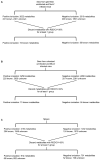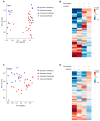Retroviral Infection and Commensal Bacteria Dependently Alter the Metabolomic Profile in a Sterile Organ
- PMID: 36851600
- PMCID: PMC9967258
- DOI: 10.3390/v15020386
Retroviral Infection and Commensal Bacteria Dependently Alter the Metabolomic Profile in a Sterile Organ
Abstract
Both viruses and bacteria produce "pathogen associated molecular patterns" that may affect microbial pathogenesis and anti-microbial responses. Additionally, bacteria produce metabolites, while viruses could change the metabolic profiles of the infected cells. Here, we used an unbiased metabolomics approach to profile metabolites in spleens and blood of murine leukemia virus-infected mice monocolonized with Lactobacillus murinus to show that viral infection significantly changes the metabolite profile of monocolonized mice. We hypothesize that these changes could contribute to viral pathogenesis or to the host response against the virus and thus open a new avenue for future investigations.
Keywords: commensal bacteria; metabolites; microbiota; retroviruses.
Conflict of interest statement
The authors declare no conflict of interest.
Figures




Update of
-
Retroviral infection and commensal bacteria dependently alter the metabolomic profile in a sterile organ.bioRxiv [Preprint]. 2023 Jan 11:2023.01.10.523497. doi: 10.1101/2023.01.10.523497. bioRxiv. 2023. Update in: Viruses. 2023 Jan 29;15(2):386. doi: 10.3390/v15020386. PMID: 36711645 Free PMC article. Updated. Preprint.
References
Publication types
MeSH terms
Grants and funding
LinkOut - more resources
Full Text Sources

